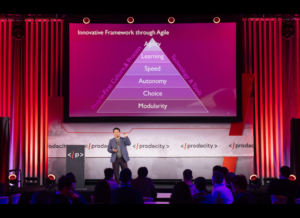Government IT administrators manage several different types of operations. There’s DevOps, which led to the creation of DevSecOps. Now, data-driven agencies are being introduced to a new operational concept: DataOps, the bridge connecting IT operations and data sciences and accelerating the use of data analytics.
DataOps Explained
Like DevOps and DevSecOps, DataOps is much more than a single technology or a group of technologies. In a DataOps environment, DevOps teams become tightly integrated with data scientists. These groups work together in a highly agile manner, similar to how developers, security, and operations managers collaborate.
The idea is to create data-driven solutions at speed. While DevOps is meant to increase development velocity, DataOps is designed to accelerate analytics velocity. DataOps teams use the data they’ve collected from various sources to make rapid improvements to their applications, so they can continually deliver a valuable user experience.
Think of a state employment security office website fielding thousands of unemployment claims per day or a federal government website processing millions of requests from U.S. citizens every week. How do people interact with those sites? Which features do they use? What kind of feedback do users provide?
DataOps teams take this information and transform it into actionable intelligence they can use to make iterative improvements to their applications. They do this continuously, often using the same principles and strategies (scrums, sprints, etc.) found in a DevOps environment. Their goal is simple: collect the data, analyze it, put it into action, and do it all over again.
 DataOps and Data Management
DataOps and Data Management
But while the goal is simple, the actual data management process is far from easy. Most agencies use multiple databases to collect and store this vital information. Some of those databases might be on-premises. Others are likely in the cloud. There may also be hybrid IT environments, where some data is stored in both places. This complexity can make it challenging for DataOps teams to effectively govern and map their data.
DataOps teams also need to be able to respond quickly in case an anomaly occurs within one of their databases. Again, the entire point of DataOps is speed—collecting and analyzing data rapidly, so teams can continuously improve their applications. A simple fault in a single database could significantly inhibit a team’s ability to accomplish this goal.
In this environment, teams need a holistic view of their entire database ecosystem—on-premises, in the cloud, and in between—and to be able to monitor data at rest and in flight. This can help DataOps teams accomplish critical tasks in multiple areas, including:
Data governance: To maintain good data governance, teams must be able to effectively manage their data as it passes between environments, from on-premises to the cloud, and wherever it’s stored. The best way to establish true control over data is through continuous monitoring from a centralized location, just like IT administrators monitor their network environments. This allows DataOps teams to ensure their data remains secure and of high quality.
Data mapping: Data mapping is critical to successful data migration. Data mapping allows DataOps teams to plot out the path data takes from one point to another, confirming the data gets to the correct target fields. With a single view of all data migration pathways, DataOps can check to see their data is flowing correctly and without error.
Data monitoring: While holistic data monitoring is important for both data governance and data mapping, it’s also essential to optimal database performance. By being able to visualize the entire database ecosystem, DataOps teams can pinpoint the root cause of a potential problem and address it quickly, so productivity can continue unabated. Artificial intelligence (AI) and machine learning play key roles in this process. A database management system with AI and machine learning capabilities can learn to spot anomalies before they occur based on historical precedence, reducing the risk of downtime and maintaining exceptional and reliable application performance.
Faster Innovation and Better Citizen Experiences
The advent of DataOps has given government IT professionals yet another powerful tool for faster innovation that fuels better citizen experiences, but their success depends on having the right data management processes in place. Taking a holistic approach to data management allows DataOps teams to get a good handle on their data across their entire environment. They can effectively monitor, map, and govern their data at scale, ensuring their applications run smoothly and securely.
Check out the SolarWinds website for more information on database monitoring.







